Optimizing Energy Consumption: A Case Study of LVDC Nanogrid Implementation in Tertiary Buildings on La Réunion Island
Abstract
:1. Introduction
2. LVDC Nanogrid Deployment
2.1. Hardware Architecture—48 VDC Distribution
2.2. Software Architecture
2.2.1. Data Communication
2.2.2. Human Machine Interface (HMI)
- In the first graph, the battery charge or discharge current (pink curve).
- In the second graph, the battery voltage (green curve) and the voltage of the PoE LED drivers (purple curve). The latter fluctuates depending on the LED lighting, which is determined by presence or brightness measurements made by the sensor connected to the driver.
- In the third graph, the power consumed or produced by the battery (blue curve) and the power consumed by the PoE drivers (purple curve).
- In the fourth graph, there is an overall analysis that overlays current and voltage measurements regarding the PV panels, the battery, and the drivers.
- The last graph displays the battery state of charge.
- The widget shows the battery temperature for visual monitoring.
3. Efficiency Evaluation Methodology
3.1. Voltage Drop
3.2. Efficiency Model
3.2.1. Efficiency for DC/AC/DC Distribution
3.2.2. Efficiency for DC Distribution
3.2.3. Superposition of DC/AC/DC and DC Distribution Efficiency
4. Results and Discussion
4.1. Experimental Testbench
4.2. Comparison between DC/AC/DC and 48 VDC Distribution for a Cable Cross-Section of 1.5 mm2
4.3. Comparison between DC/AC/DC and 48 VDC Distribution for a Cable Cross-SECTION of 2.5 mm2
5. Conclusions
Author Contributions
Funding
Data Availability Statement
Conflicts of Interest
References
- French Government. Tertiary decree n°2019-771. In JORF n°0171; French Government: Paris, France, 2019. [Google Scholar]
- French Government. Building automation and control system (BACS) decree n°2020-887. In JORF n°0177; French Government: Paris, France, 2020. [Google Scholar]
- French Government. Law n° 2015-992 of august 17, 2015 on the energy transition for green growth. In JORF n°0193 of 19th August 2015; French Government: Paris, France, 2015. [Google Scholar]
- Energy Observatory SPL Horizon Réunion. Balance Sheet Energy of La Réunion 2022. Available online: https://energies-reunion.com/nos-actions/observation/ (accessed on 15 January 2024).
- Open Data EDF Réunion. Available online: https://opendata-reunion.edf.fr/ (accessed on 15 January 2024).
- Shayan, E.M.; Najafi, G.; Ghobadian, B.; Gorjian, S.; Mamat, R.; Ghazali, M.F. Multi-microgrid optimization and energy management under boost voltage converter with Markov prediction chain and dynamic decision algorithm. Renew. Energy 2022, 201, 179–189. [Google Scholar] [CrossRef]
- Burmester, D. A review of nanogrid topologies and technologies. Renew. Sustain. Energy Rev. 2017, 67, 760–775. [Google Scholar] [CrossRef]
- Glasgo, B.; Azevedo, I.; Hendrickson, C. How much electricity can we save by using direct current circuits in homes? Understanding the potential for electricity savings and assessing feasibility of a transition towards DC powered buildings. Appl. Energy 2016, 180, 66–75. [Google Scholar] [CrossRef]
- Gerber, D.; Liou, R.; Brown, R. Energy-saving opportunities of direct-DC loads in buildings. Appl. Energy 2019, 248, 274–287. [Google Scholar] [CrossRef]
- Chauhan, R.K.; Rajpurohit, B.S. DC distribution system for energy efficient buildings. In Proceedings of the 2014 Eighteenth National Power Systems Conference (NPSC), Guwahati, India, 18–20 December 2014; pp. 1–6. [Google Scholar]
- Alsaedi, A.; Alharbi, F.; Alahdal, A.; Alahmadi, A.; Ammous, A.; Ammous, K. Low Voltage Direct Current Supplies Concept for Residential Applications. Energy Explor. Exploit. 2022, 40, 1078–1097. [Google Scholar] [CrossRef]
- Manandhar, U.; Ukil, A.; Kiat Jonathan, T.K. Efficiency comparison of DC and AC microgrid. In Proceedings of the 2015 IEEE Innovative Smart Grid Technologies—Asia (ISGT ASIA), Bangkok, Thailand, 3–6 November 2015; pp. 1–6. [Google Scholar]
- Ammous, A.; Alsaedi, A.; Alahmadi, A.N.M.; Alharbi, F.; Ammous, K. Efficiency Performances of LVDC Supplies for Residential Building. Comput. Syst. Sci. Eng. 2023, 45, 2171. [Google Scholar] [CrossRef]
- Ollas, P.; Thiringer, T.; Persson, M.; Markusson, C. Energy Loss Savings Using Direct Current Distribution in a Residential Building with Solar Photovoltaic and Battery Storage. Energies 2023, 16, 1131. [Google Scholar] [CrossRef]
- Vossos, V.; Garbesi, K.; Shen, H. Energy savings from direct-DC in U.S. residential buildings. Energy Build. 2014, 68, 223–231. [Google Scholar] [CrossRef]
- Joseph, S.C.; Ashok, S.; Dhanesh, P.R. Low voltage direct current(LVDC) nanogrid for home application. In Proceedings of the 2017 IEEE Region 10 Symposium (TENSYMP), Cochin, India, 14–16 July 2017; pp. 1–5. [Google Scholar] [CrossRef]
- Chacko, R.; Thevarkunnel, A.; Lakaparampil, Z.V.; Thomas, J. DC nanogrid for Buildings: Study based on experimental investigation of load performance and Annual energy consumption. Mater. Today Proc. 2022, 58, 352–358. [Google Scholar] [CrossRef]
- Living Energy Farm. Available online: https://livingenergyfarm.org/energy/ (accessed on 15 January 2024).
- Glasgo, B.; Lima Azevedo, I.; Hendrickson, C. Expert assessments on the future of direct current in buildings. Environ. Res. Lett. 2018, 13, 074004. [Google Scholar] [CrossRef]
- Antoniou, D.; Tzimas, A.; Rowland Simon, M. Transition from alternating current to direct current low voltage distribution networks. IET Gener. Transm. Distrib. 2015, 9, 1391–1401. [Google Scholar] [CrossRef]
- Dastgeer, F.; Gelani, H.E.; Anees, H.M.; Paracha, Z.J.; Kalam, A. Analyses of efficiency/energy-savings of DC power distribution systems/microgrids: Past, present and future. Int. J. Electr. Power Energy Syst. 2019, 104, 89–100. [Google Scholar] [CrossRef]
- Gelani, H.E.; Dastgeer, F.; Nasir, M.; Khan, S.; Guerrero, J.M. AC vs. DC Distribution Efficiency: Are We on the Right Path? Energies 2021, 14, 4039. [Google Scholar] [CrossRef]
- Beretta, D.; Mocoteguy, P.; Sessa, G.; Limagne, M.; Boucher, J.-E. A 100% renewable isolated microgrid in Mafate. In Proceedings of the CIRED 2018 Ljubljana Workshop on Microgrids and Local Energy Communities, Ljubljana, Slovenia, 7–8 June 2018. [Google Scholar]
- Abbezzot, C.; Francou, J.; Calogine, D. Demand side management applied to a standalone microgrid. Int. J. Smart Grid Clean Energy 2022, 11, 127–134. [Google Scholar] [CrossRef]
- Moussa, S.; Ghorbal, M.J.-B.; Slama-Belkhodja, I. Bus voltage level choice for standalone residential DC nanogrid. Sustain. Cities Soc. 2019, 46, 101431. [Google Scholar] [CrossRef]
- Habibi, S.; Rahimi, R.; Ferdowsi, M.; Shamsi, P. DC Bus Voltage Selection for a Grid-Connected Low-Voltage DC Residential Nanogrid Using Real Data with Modified Load Profiles. Energies 2021, 14, 7001. [Google Scholar] [CrossRef]
- Richard, L.; Boudinet, C.; Ranaivoson, S.A.; Rabarivao, J.O.; Befeno, A.E.; Frey, D.; Alvarez-Hérault, M.-C.; Raison, B.; Saincy, N. Development of a DC Microgrid with Decentralized Production and Storage: From the Lab to Field Deployment in Rural Africa. Energies 2022, 15, 6727. [Google Scholar] [CrossRef]
- Uddin, M.; Mo, H.; Dong, D.; Elsawah, S.; Zhu, J.; Guerrero, J.M. Microgrids: A review, outstanding issues and future trends. Energy Strategy Rev. 2023, 49, 101127. [Google Scholar] [CrossRef]
- IEEE P802.3bt/D3.6; IEEE Draft Standard for Ethernet—Amendment 2: “Power over Ethernet over 4 Pairs”. IEEE: Piscataway, NJ, USA, 2017; pp. 1–36.
- Muthuvel, P.; Daniel, A.S.; Paul, K.S. Sizing of PV array in a DC nano-grid for isolated households after alteration in time of consumption. Eng. Sci. Technol. Int. J. 2017, 20, 1632–1641. [Google Scholar] [CrossRef]
- Dahiru, T.A.; Tan, W.C. Optimal sizing and techno-economic analysis of grid-connected nanogrid for tropical climates of the Savannah. Sustain. Cities Soc. 2020, 52, 101824. [Google Scholar] [CrossRef]
- Othee, A.; Cale, J.; Santos, A.; Frank, S.; Zimmerle, D.; Ghatpande, O.; Duggan, G.; Gerber, D. A Modeling Toolkit for Comparing AC and DC Electrical Distribution Efficiency in Buildings. Energies 2023, 16, 3001. [Google Scholar] [CrossRef]
- Ore, J.; Groll, A.E. Design and Development of a Decentralized and Distributed IoT Home Monitoring System Within a DC Nanogrid. In Proceedings of the 2020 Building Performance Analysis Conference and SimBuild Co-Organized by ASHRAE and IBPSA, Online, 29 September–1 October 2020. [Google Scholar]
- IOS-Net. Available online: https://galilee.univ-reunion.fr/ (accessed on 15 January 2024).
- OPERAT Platform. Available online: https://operat.ademe.fr/ (accessed on 15 January 2024).
- Efficiency Division of California Energy Comission. Available online: https://www.energy.ca.gov/about/divisions-and-offices/efficiency-division (accessed on 26 February 2024).
- Sandia National Laboratories. CEC Inverter Test Protocol. Available online: https://pvpmc.sandia.gov/modeling-guide/dc-to-ac-conversion/cec-inverter-test-protocol/ (accessed on 26 February 2024).
- Dunlop, E.D.; Gracia Amillo, A.; Salis, E.; Sample, T.; Taylor, N. Determination of the Efficiency of Inverters. C2 Energy Efficiency and Renewables Directorate Energy, Transport and Climate, Joint Research Centre. In Proceedings of the PV Expert Meeting, Ispra, Italy, 31 October 2018. [Google Scholar]
- Technical Union of Electricity (UTE). NFC 15-100 Low-Voltage Electrical Installations; AFNOR Editions: Saint-Denis, France, 2002. [Google Scholar]
- Hafsi, K.; Genon-Catalot, D.; Thiriet, J.-M.; Lefevre, O. DC building management system with IEEE 802.3 bt standard. In Proceedings of the 2021 IEEE 22nd International Conference on High Performance Switching and Routing (HPSR), Paris, France, 7–10 June 2021; pp. 1–8. [Google Scholar]
- Garbesi, K.; Vossos, V.; Shen, H. Catalog of DC Appliances and Power Systems; Lawrence Berkeley National Laboratory, University of California: Berkeley, CA, USA, 2012. [Google Scholar]

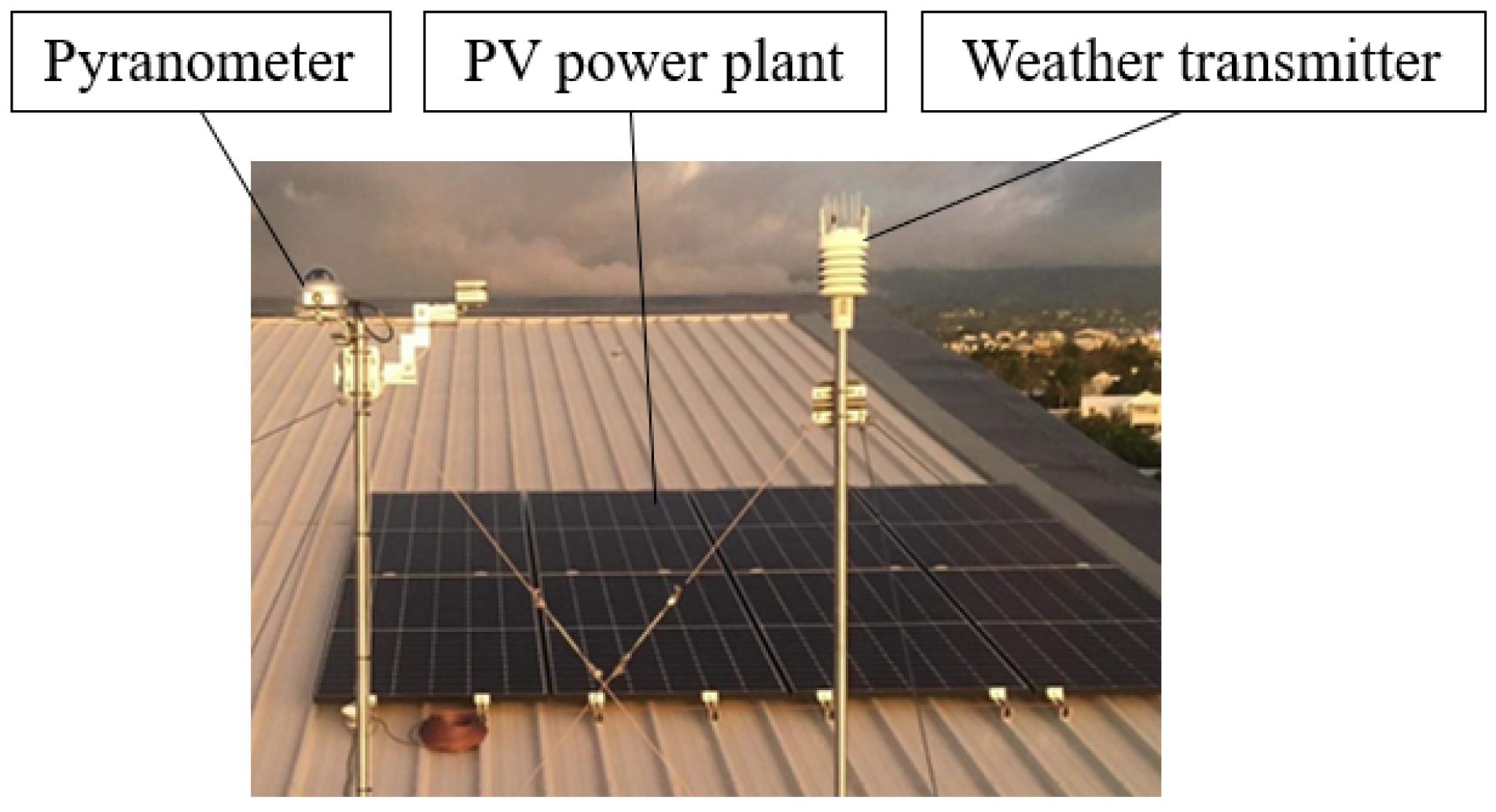
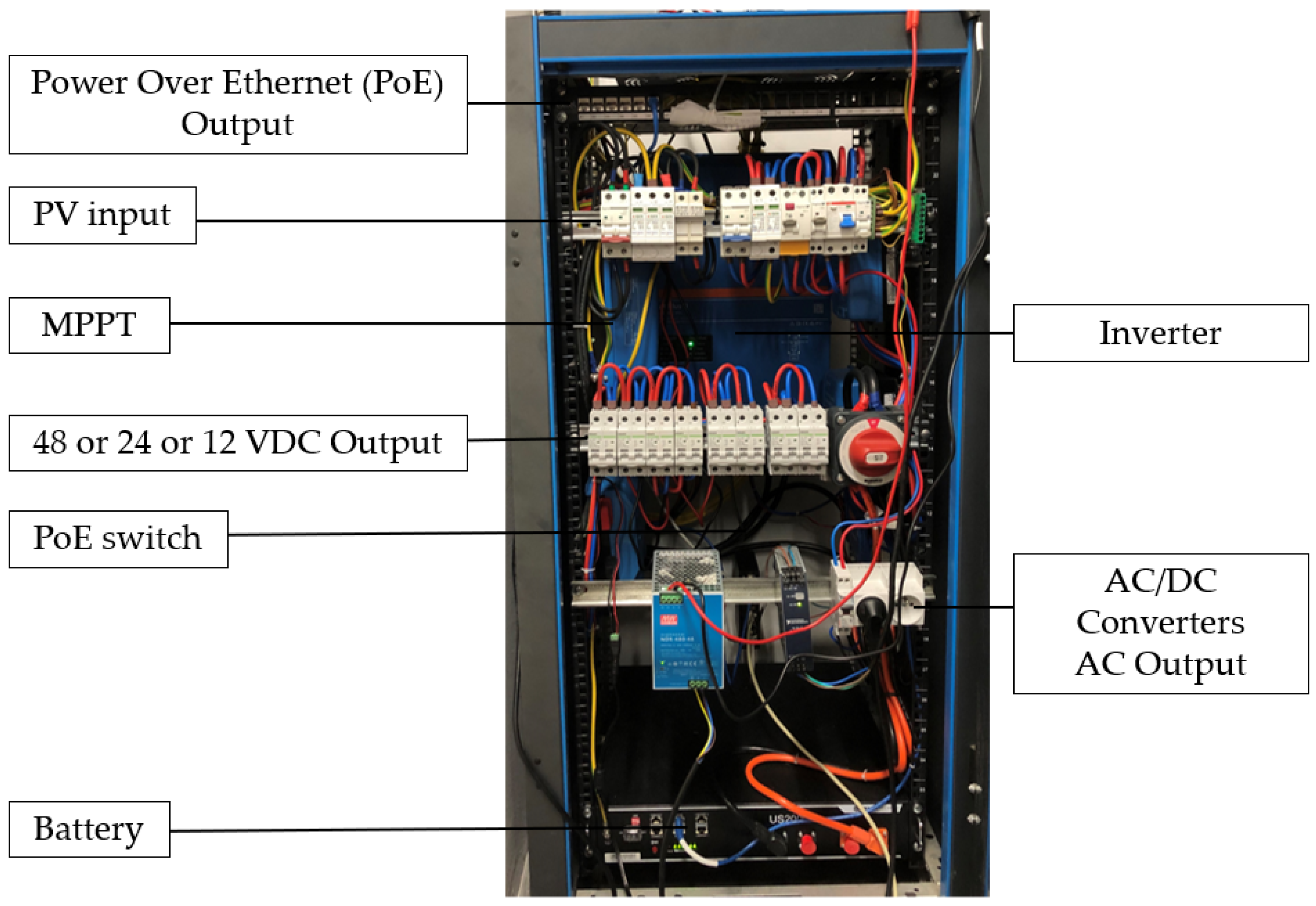
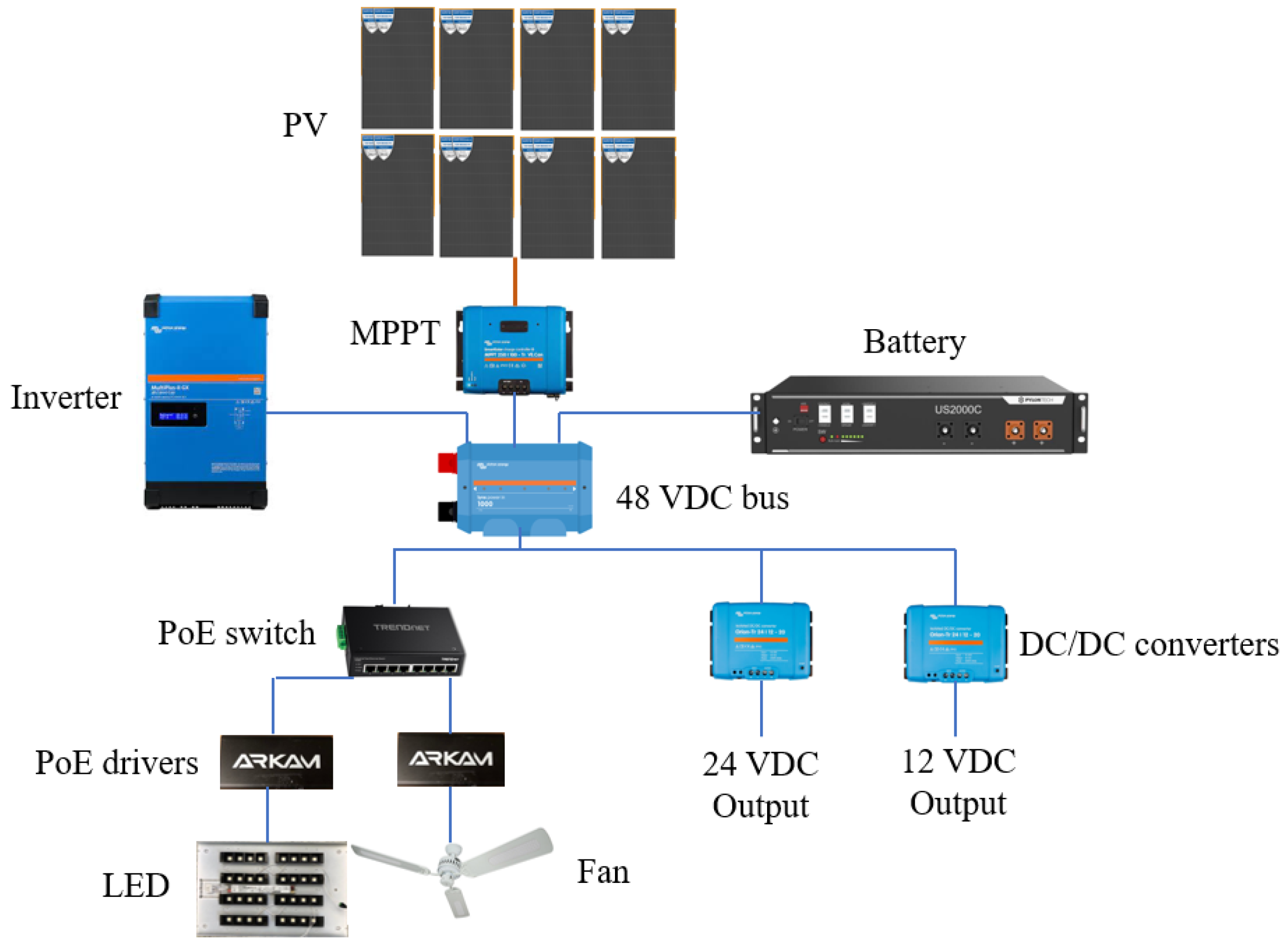

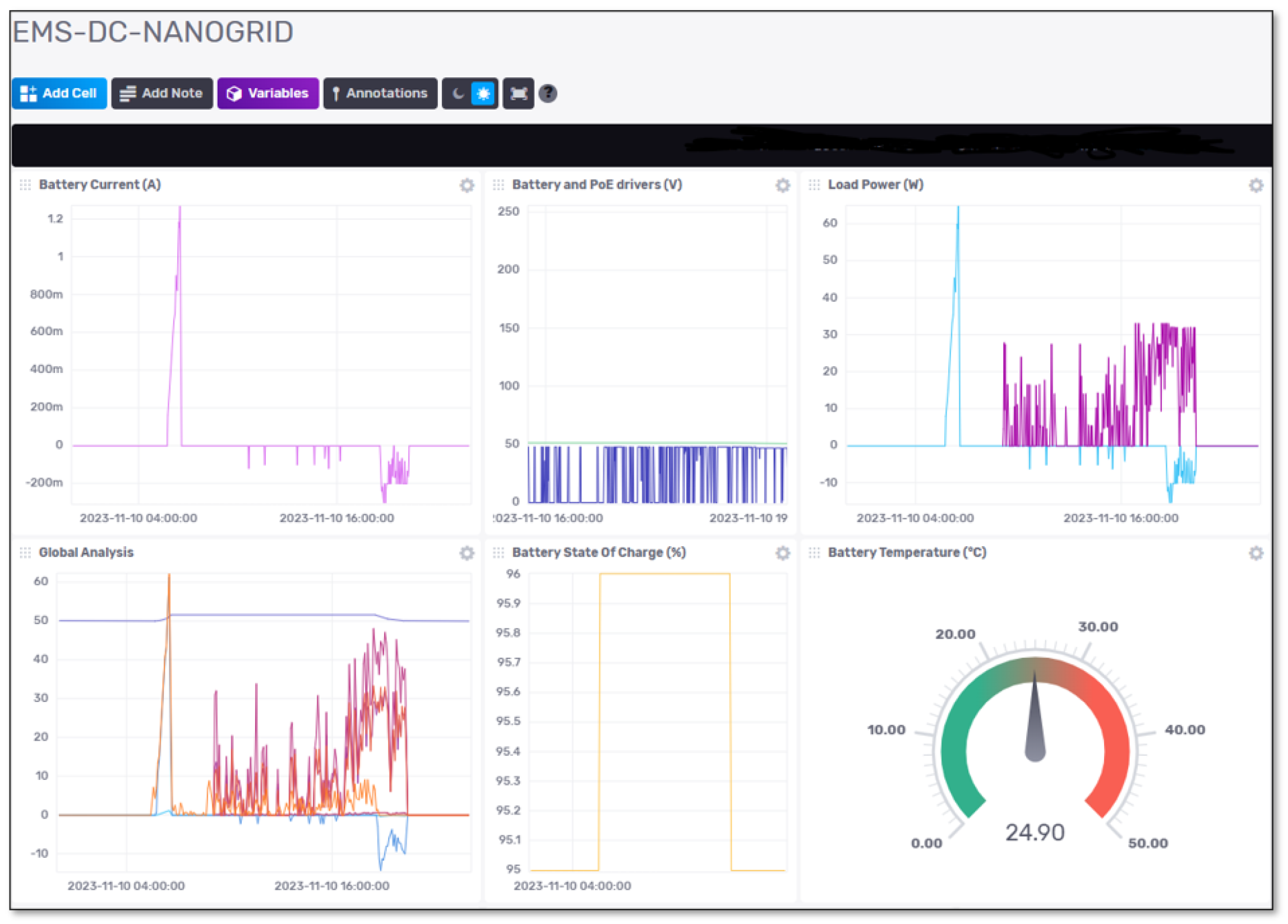

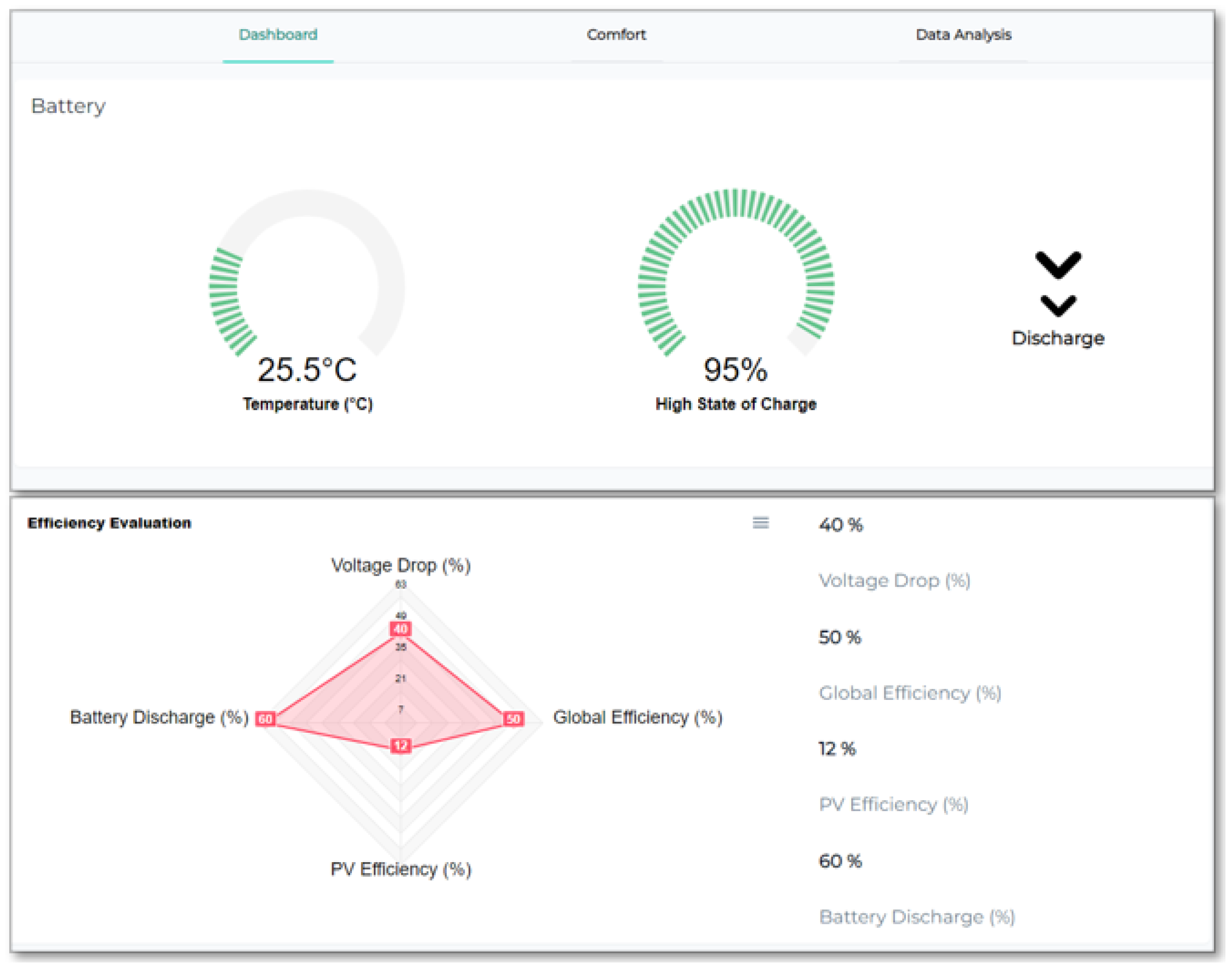
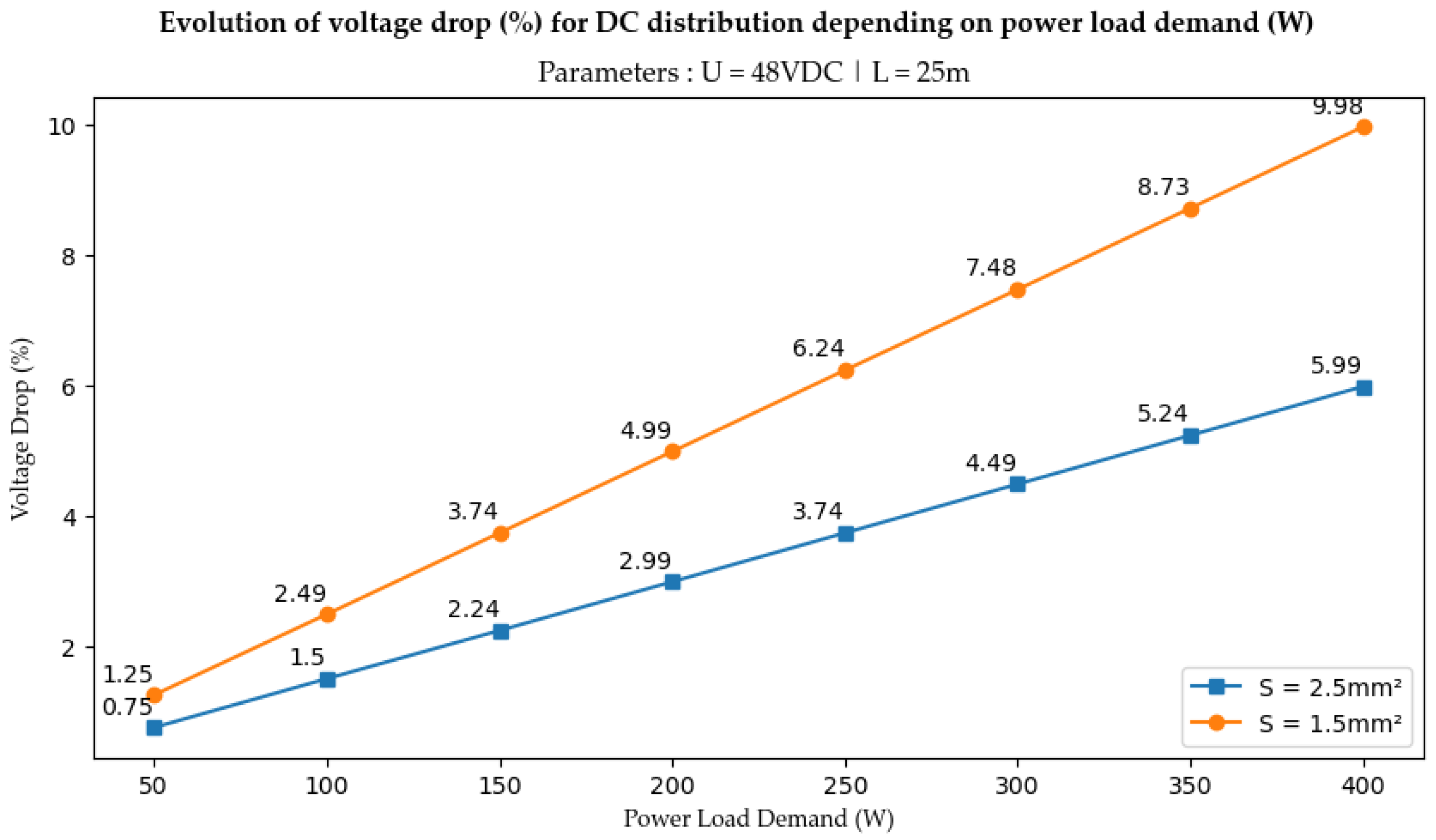


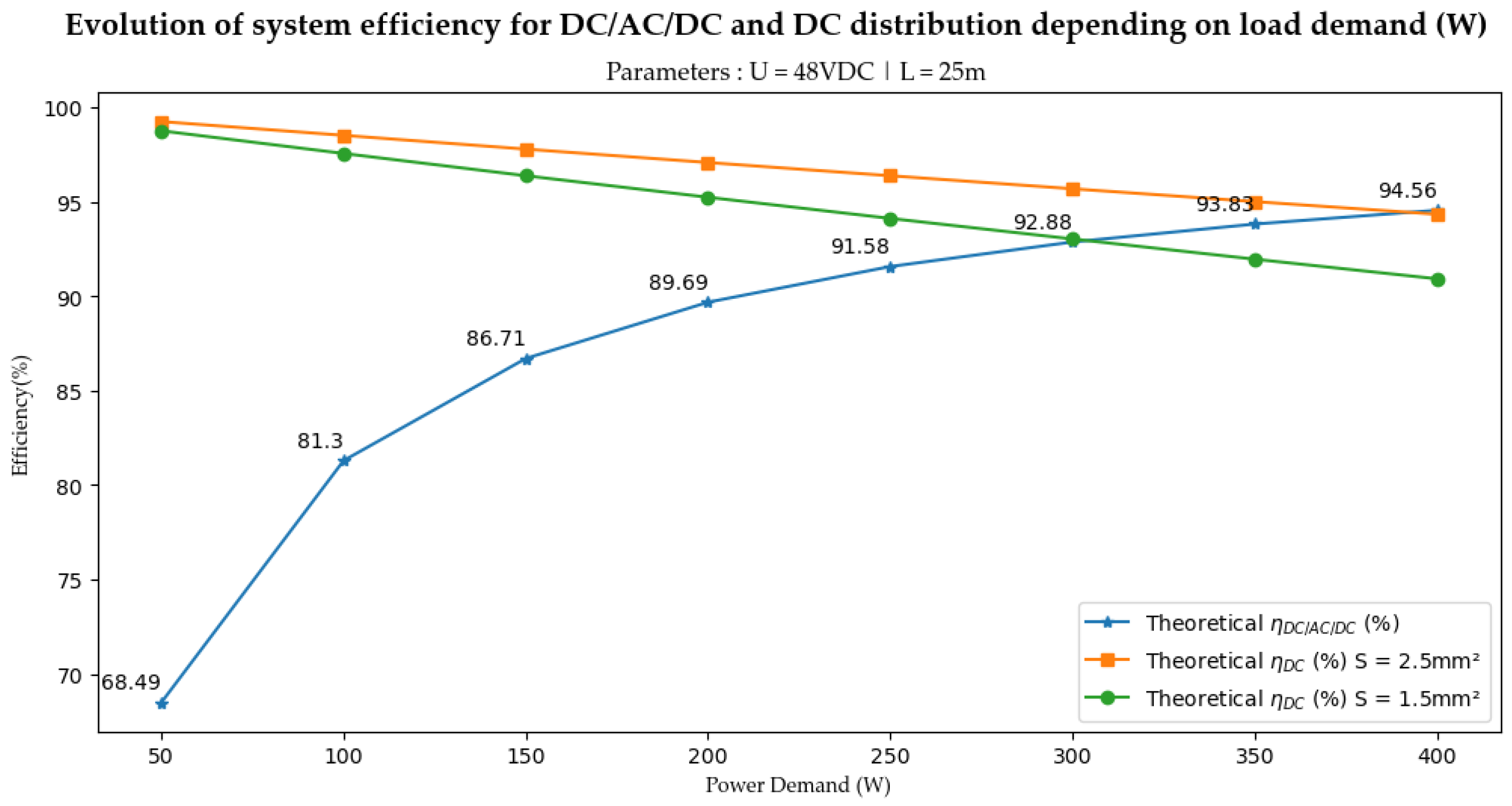
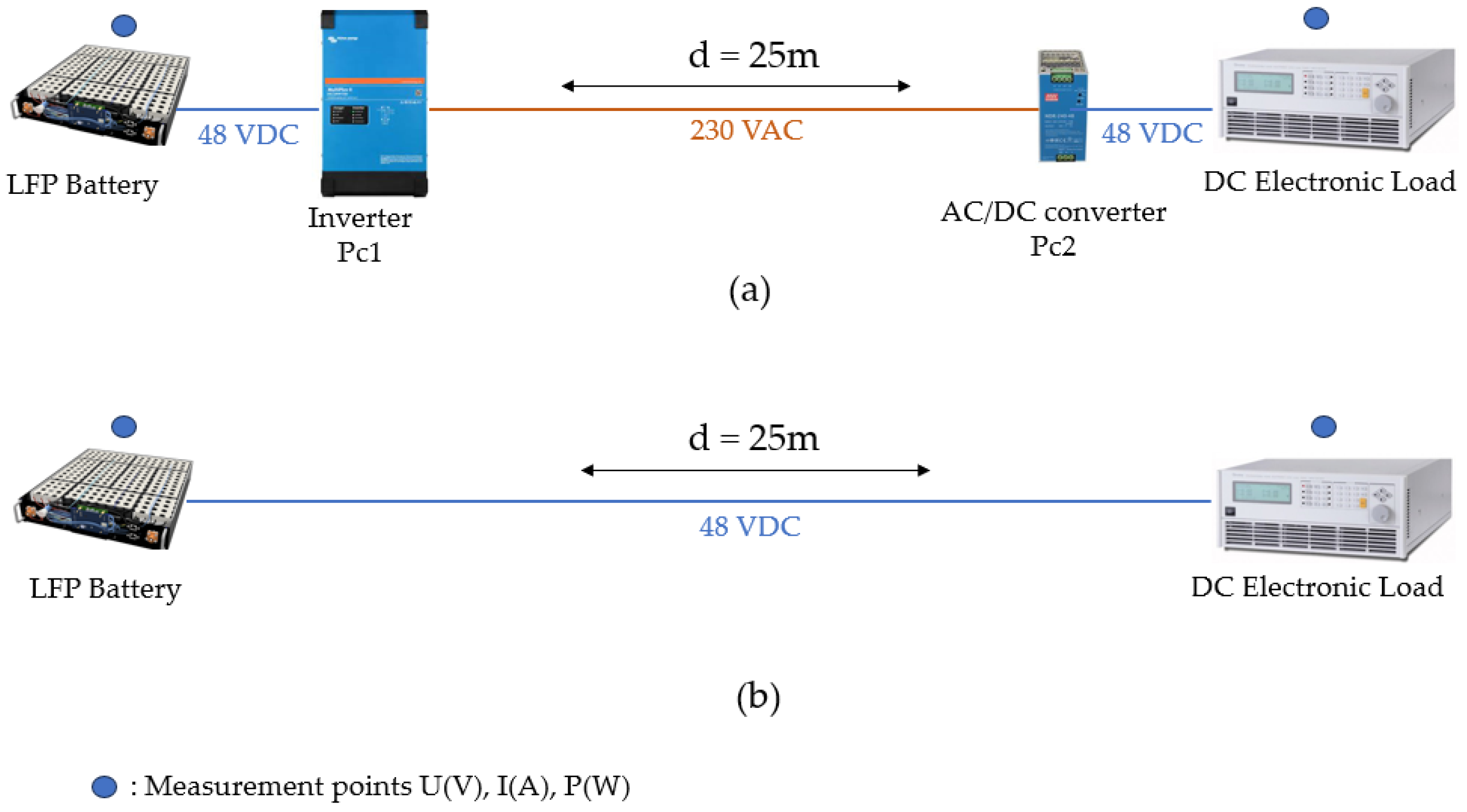

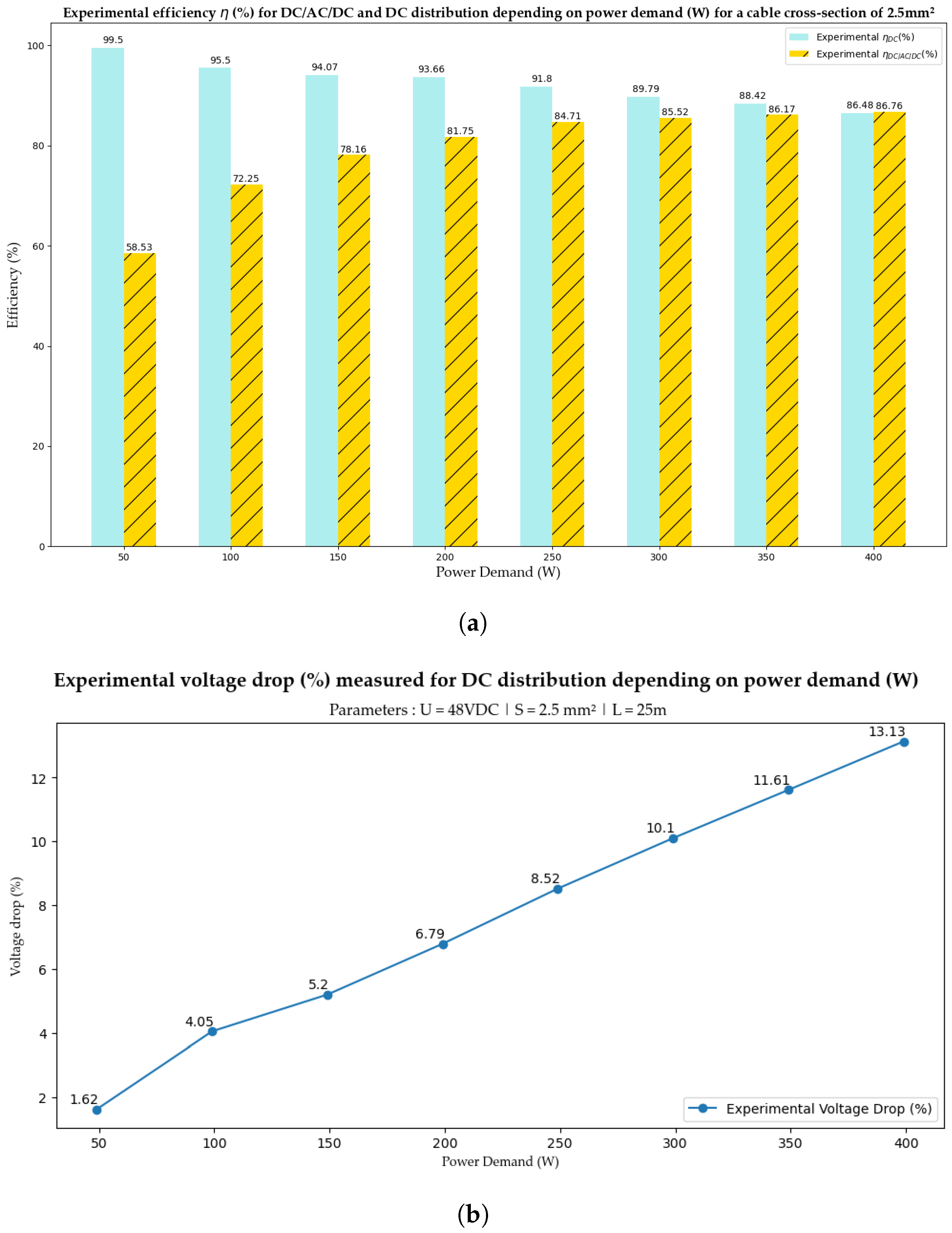
| Equipment | References | Manufacturer | Power (W) |
|---|---|---|---|
| Battery | US2000C | Pylontech | - |
| Inverter | Multiplus II | Victron | 18 W |
| AC/DC converter | NDR-240-48 | Meanwell | 5 W |
| DC Electronic load | 63800 | Chroma ATE | 1.8 kW max |
Disclaimer/Publisher’s Note: The statements, opinions and data contained in all publications are solely those of the individual author(s) and contributor(s) and not of MDPI and/or the editor(s). MDPI and/or the editor(s) disclaim responsibility for any injury to people or property resulting from any ideas, methods, instructions or products referred to in the content. |
© 2024 by the authors. Licensee MDPI, Basel, Switzerland. This article is an open access article distributed under the terms and conditions of the Creative Commons Attribution (CC BY) license (https://creativecommons.org/licenses/by/4.0/).
Share and Cite
Graillet, O.; Genon-Catalot, D.; Lucas de Peslouan, P.-O.; Bernard, F.; Alicalapa, F.; Lemaitre, L.; Chabriat, J.-P. Optimizing Energy Consumption: A Case Study of LVDC Nanogrid Implementation in Tertiary Buildings on La Réunion Island. Energies 2024, 17, 1247. https://doi.org/10.3390/en17051247
Graillet O, Genon-Catalot D, Lucas de Peslouan P-O, Bernard F, Alicalapa F, Lemaitre L, Chabriat J-P. Optimizing Energy Consumption: A Case Study of LVDC Nanogrid Implementation in Tertiary Buildings on La Réunion Island. Energies. 2024; 17(5):1247. https://doi.org/10.3390/en17051247
Chicago/Turabian StyleGraillet, Olivia, Denis Genon-Catalot, Pierre-Olivier Lucas de Peslouan, Flavien Bernard, Frédéric Alicalapa, Laurent Lemaitre, and Jean-Pierre Chabriat. 2024. "Optimizing Energy Consumption: A Case Study of LVDC Nanogrid Implementation in Tertiary Buildings on La Réunion Island" Energies 17, no. 5: 1247. https://doi.org/10.3390/en17051247






